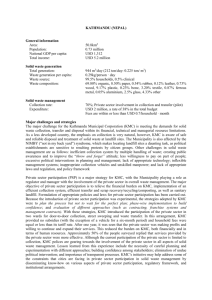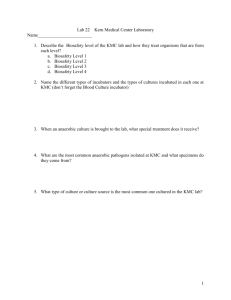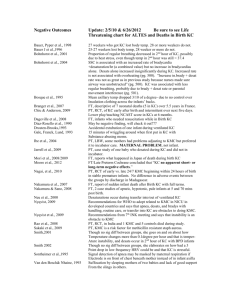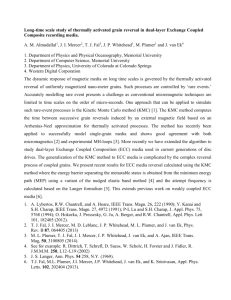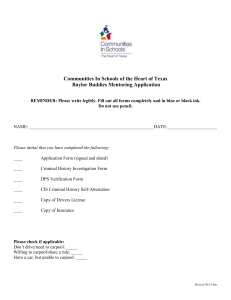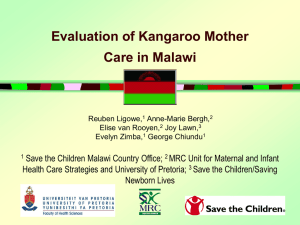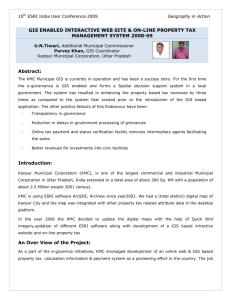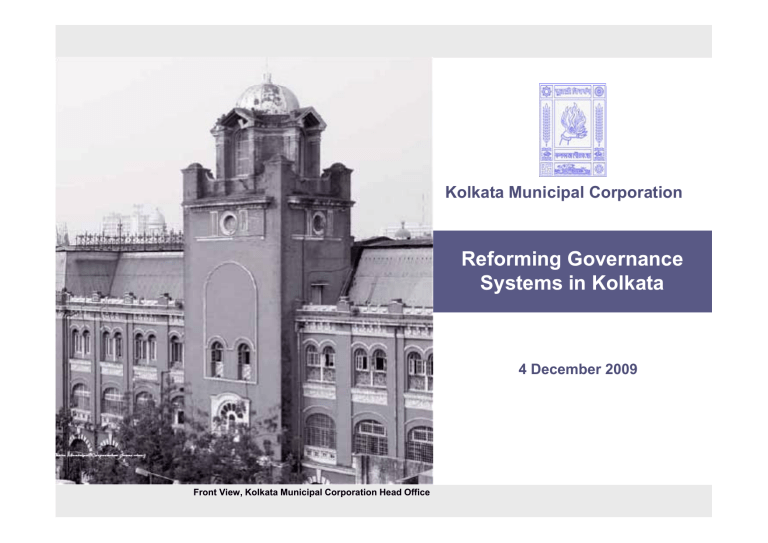
Kolkata Municipal Corporation
Reforming Governance
Systems in Kolkata
4 December 2009
Front View, Kolkata Municipal Corporation Head Office
Urbanization in India ..
At present
present, India has 3 mega-cities
mega cities
– Kolkata is the 7th largest city in world by
population and 2nd in India, only after Mumbai
The Kolkata Metropolitan Area (KMA), comprising
of Kolkata and 40 other ULBs, spread on both
banks of river Hooghly, is a giant metropolis of
about 15 million people,
people stretching over 1850 sq.
sq
km. area
Kolkata Municipal Corporation (KMC) covers
approximately 31% of the KMA population within
only 11% of the total area of KMA
Kolkata Municipal
Corporation
For a huge and phenomenally growing urban agglomeration like Kolkata, the biggest
challenge is sustainable development
© 2009 Kolkata Municipal Corporation. All rights reserved.
2
Comparison of the 4 metropolitan cities in India
Large floating
population needs
to be provided
facilities, yet they
are outside KMC’s
ta base
tax
Parameters
Kolkata
Delhi
Mumbai
Chennai
Area (in sq. km.)
187
1397
438
174
Population
4.5
4
5 mn
+ 5.5 mn
(floating)
9.88 mn
11.98 mn
4.34 mn
Density of population (per sq.
km.)
24 499
24,499
9 294
9,294
27 209
27,209
24 801
24,801
Sex Ratio (females per 1000
males)
828
836
859
953
Literacy rate
85%
86.4%
91%
87.4%
Slum Population
1.48 mn
1.85 mn
6.48 mn
0.82 mn
Slum dwelling
Sl
d lli population
l ti (% off
total population)
33%
18.8%
48.8%
17.7%
Literacy rate in slums (%)
73.3%
67.4%
83%
76.3%
805
780
770
974
Sex ratio in slums
1/3rd of city
living in
slums !!
© 2009 Kolkata Municipal Corporation. All rights reserved.
3
3
Managing and delivering civic services in a large
metropolis like Kolkata is a Herculean task ..
Resident population: 4.5 mn
Floating population: 5.5 mn
Area of the city: 187 sq km
Density: 25,000
25 000 per sq km
Sewer Lines:
1610 k
km
Health Care:
105 clinics and
118 health
units
Solid Waste:
4000 MT/ day
Water supply:
350 MGD to 5
mn people
Roads
management:
6000 km of
roads in the
city
Education: 354
primary
educational
institutions
with more than
40000
students
Slums:
5500 slums
Parks and
gardens:
652 parks and
gardens
Buildings:
~1 million
Slum
population:
1.5 mn
© 2009 Kolkata Municipal Corporation. All rights reserved.
4
Being the primary ULB in Kolkata, KMC realizes the
importance of governance systems in order to cope
with the rapid urbanization ..
KMC envisaged interventions in the following areas to improve governance systems
Institutional Capacity
Building and Training
Decentralization and
Delegation of powers
KMC
Inculcate a citizen centric
approach to service delivery
Introduction of e-governance
and Information Technology
5
KMC prior to the 1980s
Municipal Corporation for Kolkata was created in 1727 under a Royal Charter.
Partly elected council created in 1876 but in 1899 government appointed executive
administration supersedes it.
In 1923 fully democratically elected municipal body headed by a Mayor formed under
the Calcutta Municipal Act, 1923.
From 1952, the KMC was governed by the Calcutta Municipal Act of 1951. The Act
envisaged the Corporation as a policy making, directive and rule making body. As per
this Act, KMC area had been divided into 75 wards and the concept of Boroughs was
introduced.
Amending Acts of 1964 resulted in the increase of number of wards under KMC area to
100.
An Administrator appointed by the State Govt. was at the helm of KMC between 1972
and 1984
6
In 1980, first step towards decentralization achieved
through formation of Boroughs under the KMC Act ..
The institutional framework
Kolkata Municipal Corporation
Policy
P
li making
ki
framework
f
k
In Cabinet system
Administrative framework
Mayor, Mayor – in
council
Municipal
Commissioner
15 Boroughs
Borough chairperson
Head of departments
141 wards
Ward councilors
Executives
In 1992, the 74th Constitutional Amendment Act (CAA), paved the way for further
decentralization through formation of ward committees
7
Despite provisions in the Act for decentralization, KMC
was still rooted to centralized system of governance ..
A systematic mechanism for decentralization to Boroughs had not fully evolved
KMC realized that its OD systems, budgets, personnel needed to be aligned to the
roles and responsibilities of the decentralized system
It was also observed that the top management were burdened with day to day work
and had less time for institutional coordination, planning and strategizing
KMC realized the need for an institutional capacity building program to strengthen its
governance systems to improve service delivery
8
In 2003, KMC embarked on reforming governance systems
through an institutional capacity building program ..
A feasibility
eas b y study
s udy conducted
co duc ed by several
se e a agencies
age c es accorded
acco ded p
priority
o y interventions
e e o s in the
e
following areas
– sewerage and drainage,
– solid waste management,
– introduction of IT and e-governance
– organizational development and governance
– social
i ld
development
l
t and
d poverty
t alleviation
ll i ti
– financial management and resource mobilization
A programme to build the capacity of KMC to manage the delivery of urban services to
the citizens of Kolkata in a sustainable & equitable manner was initiated in 2003-04
KMC has also undertaken several projects in the priority areas with the support of
external agencies
9
One of the primary focus areas in CBP was Organizational
Development with emphasis on Delegation and
D
Decentralization
t li ti
..
KMC
Ce
engaged
gaged the
e services
se ces of
o A F Ferguson,
e guso , a renowned
e o ed OD
O consultant,
co su a , to
o rollout
o ou O
OD
reforms
Delegation of powers was first taken up in order to facilitate efficiency improvement
– Top structure revamped with creation of a 2nd tier of administration under Municipal
Commissioner (MC).
– Span of control of MC substantially rationalized to allow him to focus more on inter
planning
g and strategizing
g g
institutional coordination, p
– Activities were logically grouped under senior officials in order to improve efficiency
– Administrative and financial powers were delegated across the organization
– ‘Empowering
Empowering the limbs’
limbs , a manual on Delegation of Power in KMC was prepared and
published
– Several workshops were organized on delegation and decentralization; decisions were
taken through a consultative process and initiatives further streamlined
10
A consensus based approach was adopted to facilitate
delegation
g
and decentralization ..
A Borough
o oug S
Strengthening
e g e g Plan
a ((BSP)
S ) Co
Committee
ee was
as se
set up co
comprising
p s g important
po a internal
e a
stakeholders to look into, deliberate upon and recommend on different aspects of Borough
Strengthening
The committee discussed all aspects of decentralisation along with various options for its
implementation. The entire process was enriched with wholehearted participation of all the
members of the Committee.
Two workshops were held to discuss and finalize the BSP roadmap. Recommendations of
th BSP C
the
Committee
itt received
i d iin-principle
i i l approvall ffrom th
the MIC
MIC.
The BSP roadmap clearly lays out the administrative and financial responsibilities of the
personnel at Borough and Central level
The functioning of Ward Committees was streamlined and regularized. New rules have been
devised and implemented.
11
The OD reforms also considered certain other aspects in
order to strengthen
g
the institutional framework ..
Transfer of civic functions from other para-statal
agencies
i to KMC such
h as S
Street Li
Lights
h ffrom
KMDA, Drainage Pumping Stations in added
areas from KMWSA, etc.
Several new departments such as Social Sector
and Town Planning were created to give due
importance to certain focal areas
Several Cells such as PPP Cell
Cell, Bustee Services
Cell, Unit Area Assessment Cell were created to
give impetus to certain specific reform areas,
initiatives
KMC encouraged lateral entry of experts in
various fields to support them in rolling out
several reform initiatives, projects
Training needs for various cadres of personnel in
KMC departments were identified and
documented
More than
M
th 6100 KMC personnell off different
diff
t
cadres have been trained in relevant fields such
as management, computers, etc.
KMC employees attending trainings
12
Impact of Organizational Development
initiatives
Delegation of Powers has led to significant simplification of
workk approvall process, lleading
di to expeditious
di i
service
i
delivery
Examples of improvement in service delivery due to
simplified workflow process
– Time taken for contractor payments reduced from 18
months to 3 months
– Time taken for simple mutation reduced from 20 days
to less than one week
– Technology has also enabled faster service delivery –
I
Issue
off Birth
Bi th and
dD
Death
th certificates,
tifi t
Trade
T d Licences,
Li
etc.
Large scale training undertaken by KMC has led to higher
motivation levels and enhanced capacity of staff
Results of Employees’ Survey indicates that employees are
by and large happy with the recent improvements
75% felt
f lt that
th t file
fil processing
i time
ti
reduced
d
d – 30 d
days tto 11
days
Results of Employees’ Survey
conducted by IPE in 2009
Employees Satisfaction
(0-5
(0
5 scale)
Overall Rating
Pension Management
Support from sub staff
Guidance by superiors
Compensation
Training
4.19
4.08
4.06
3.94
3.51
3.51
13
KMC identified e-Governance and IT as one of the
drivers to facilitate good governance ..
Need for common
Citizen Services
Increased Citizen
Awareness
2006-2008
2002
E-GOV
CAPACITY
BUILDING
2000
KMC
WEBSITE
1996
STANDALONE
SYSTEMS
Demand
for
efficient services
1974
DATA
PROCESSING
CENTRE
SETUP
14
In 2003, KMC’s computer systems has limited
networking, poor information sharing and unorganized
data across departments
KMC engaged the services of Tata Consultancy Services, to rollout IT and e-governance
reforms
Capacity building for e-Governance divided into the following modules
Business Process Re-engineering (BPR)
Development
D
l
t and
dD
Deployment
l
t off M
Municipal
i i l Ad
Administration
i i t ti S
System
t
(MAS)
Major Hardware and Network Procurement and Operationalisation
Training across all levels
Facility
F ilit M
Managementt ffor day
d to
t day
d functioning
f
ti i off the
th Data
D t Centre
C t and
d Network
N t
k
A full-fledged IT department with IT Cadre consisting of 60 personnel has been formed for
supporting the IT functions of KMC
Appointment of an MIS expert to oversee BPR
BPR, Training and MAS activities
KMC’s embarked on an ambitious computerization initiative to helped it tide over the
deficiencies and improve revenue generation and cost efficiency
15
ICT based e-Governance Model & Positioning of KMC
Phase 1 - Information
Ph
I f
i : Being
B i present on
the web providing the public with relevant
information. Rules, Policies etc
Phase 2 – Interaction : People ask
questions, over e-mail, use search
engines, download forms and documents.
Th
These
save titime.
KMC @ 2010
KMC NOW@ 2008
KMC 2 Yrs Back
KMC 5 Yrs Back
Phase 3 - Transaction : Technology
complexity increases. Complete
transactions are done electronically.
Example mutation of property, issuance
of Birth Certificates, extension/renewal of
T d Li
Trade
Licenses etc
t
Phase 4 – Transformation : Single
window Municipal Services
16
E governance : IT Strategy Framework
E- Gov Vision
Principles
M
Monitori
ing & Me
easurem
ment
Framew
work
Objectives
Business/Information
Technology
Define Business Architecture & Applications Need
IT Organization
Knowledge Updating
Change Management
Buy-In
Operational Process
Services Mgmt
SLAs
Application Architecture
Hardware Architecture
Network Architecture
Security Architecture
Information Technology Infrastructure
Implementation Approach / Operational Plan
Process
improvement
is prerequisite to
use
Technology
as tool to set
& achieve
goals
Technology is
used
d to
t improve
i
efficiency and
effectiveness
Talented
people are a
very important
y
element in any
organization
17
Due emphasis was given to IT Infrastructure
development
p
to start with
KMC formed a committee comprising of experts from the reputed educational institutions IIT Kharagpur,
Kh
J d
Jadavpur
U i
University,
i Indian
I di Statistical
S i i l Institute
I i
and
d Bengal
B
l Engineering
E i
i and
d
Science University along with officials from KMC
Central Server has been commissioned in a well designed Data Centre owned by the
Corporation
About 80 Major outlying city offices have been centrally connected through dedicated and
backup links
A Disaster
Di
t R
Recovery Sit
Site tto ensure smooth
th running
i off operations
ti
iin case off ffailure
il
off
Primary site, is complete
Major Hardware procured and commissioned through a fully equipped Central Data Centre
All 15 B
Borough
h offices
ffi
h
have ffull-fledged
ll fl d d Vid
Video C
Conferencing
f
i ffacilities
iliti with
ith th
the C
Central
t l
Municipal Office
Data Centre management outsourced to hardware vendors for 10 years
Network Management outsourced for 5 years
18
KMC-Network
15 Boroughs
141 Wards
& Ward Committee
CENTRAL
MUNICIPAL
OFFICE
CITIZEN
COUNTERS
5 Lighting Zones
and CMO
18 WS pumping stns
incl far flung PALTA
19 Drainage
Pumping Stations
Single stop Citizen Counters
planned at
suitable areas in the city
Central Data
Centre
Citizen Domain
110 Ward Health Units
70 Malaria Clinics
27 Dispensaries
21 Health Admin Units
4 Maternity Homes
1 TB Hospital
10 TB Units
7 Crematoria
7 Burial Grounds
DR site
BSNL providing the Network
24 Markets
6 Assmt Collection
Centres
16 Treasuries
15 Borough
Conservancy
offices
8 License Centres
19
KMC’s e-governance model
Back End
Front End
Secured
Intranet
Secured
Intranet
Delivery Channels
Website
Citizen
Centres
KMC Interface:
Ward,
a d, Borough
o oug Offices
O ces
Database
Servers
Treasury/
Dept counters
Web
Servers
Payment
Gateway
DATA CENTER
Security
Citizen/Vendors/
& other External
Stakeholders
Application
Servers
NMS
Storage
Business
Continuity
Core Applications
Departmental Apps.
S
Support
t Apps.
A
Collaboration
&E
E-mail
il
Office Mgmt
&W
Workflow
kfl
20
Water generation centre - PALTA
80+ offices connected
Major Citizen Centres
Central Municipal Office
Solid Waste Dumping
Ground
Water Generation Centre
21
21
MAS was designed to be a holistic enterprise model
GIS
MIS
Data Warehouse
Stakeholders
Municipal Administration System (MAS)
Financial
Accounts
Finance
T
Treasury
Auditing
Budgeting
Bank
Reconciliation
Revenue
Property Tax
Bldg. Fees
Trade licensee
Water Chg.
Drainage Obs.
Leased Prop.
Mkt. Stallage
Adv/Car
d /
Parking
Amusement Tax
User Charges
Civic
Services
Solid Waste
Health
Education
Engineering
Water Supply
Sewerage &
Drainage
Planning &
Designing
Lighting &
Electricity
Proj & Dev
Parks/Garden
Back
Office
Assets
H.R.
Poverty
Inventory
IT
Estate
HR DB
Poverty DB
Procure
Law
Other Assets
Payroll
Bustee
Stores
Pl t &
Plant
PF
Secretary
Press/IPR
Vigilance/
Corruption
Control
Machinery
Pensions
Services
Programs
Schemes
S
Supply
l
Contract
Central web based architecture framework
Secured Networked Data Centre and Disaster site
Workflow based approvals
Future enablement of online credit card based payments
22
Development of the Municipal Administration System
(MAS)
The Municipal Administration System envisages computerization of all departments and
interconnecting them for greater operational efficiency
The following applications have been rolled out as part of MAS
Name of the Application
Operational from
Name of the Application
Operational from
Assessment Collection
Head Office + all other units
Parks and Gardens dept. app
Head Office
PD Bill collection
All treasury centres and all eKolkata centres
Survey & Land Estate dept. app
Head Office
Advertisement dept. app
Head Office
Birth Registration
All boroughs
Amusement dept. app
Head Office
Death Registration
Head Office
Health Management System
Head Office
Building dept. app
Head Office and all Boroughs
Education dept. app
Head Office
Markets dept
dept. app
All markets accessed centrally
from SS Hogg market and
Gariahat Market through net
Social sector dept. app
Head Office
Law
Head Office, Town Hall
Head Office
Licence dept. app
All units including Head Office
I t
Internal
l Audit
A dit d
dept.
t app
M it d ffrom Head
Monitored
H d Offi
Office
Water supply and Drainage Revenue Generation,
Generation Collection
Parking dept. app
Head Office
Bustee Cell app
Head Office
Asphultum Plant
Goragacha Plant
Project Management Unit
Head Office
Common Collection Module
Head office and all e
e-Kolkata
Kolkata
centres
Revenue Module
Head Office
Group Insurance
Head Office
Head Office, e-Kolkata centres
and Borough Offices
CMATP
Head Office
Complaint Management
23
Effective use of MIS in different departments has facilitated
improved
p
service delivery
y
MIS Menu for Assessment department
- handles property details for over
6 lakh assessees
MIS Menu for Markets department handles details for all 27 markets
across the
th city
it maintaining
i t i i
details of over 14000 stall
holders
MIS Reports
R
t are also
l generated
t d for
f
•
Licence department (more than 5 lakh traders)
•
Advertisement (6000 hoardings)
•
Education (250 KMC schools)
MIS Reports
R
t are also
l generated
t d for
f
•
Water Supply (8000 commercial connections)
•
Building (1 million buildings in the city)
The MIS system has facilitated accurate record keeping for better monitoring and has
resulted in faster workflow processes in all departments
24
Impact of e-Governance initiatives
It takes 2-3 minutes for an online transaction through barcode based collection - 1/5th of
the time it used to take per transaction earlier
Increase in overall productivity has led to increase in revenue collected by the
departments to the tune of 30%
Accurate record keeping (validation is imposed before recording data)
Data consistency (across locations, systems)
Work is in progress to digitize department wise data to achieve greater transparency and
better administration
All citizen facing transactions are done online across the counter
Any where payment of bills, dues for citizens has increased convenience and compliance
ERP based system to facilitate improved financial management and better control over
KMC stores, engineering departments by tracking the entire lifecycle of a transaction
Double entry accrual based accounting systems are in place to facilitate easier
identification of cost centers
25
A Geographical Information System (GIS) is being
developed
p to facilitate improved
p
decision making
g in
KMC area ..
GIS being introduced for:
– Public Infrastructure Mapping
– Tax mapping, Poverty Mapping
– Revenue Distribution Mapping
– Defaulter information, Unassessed Property
– Monitoring of Civic Services
GIS work was divided into 2 components –
– Physical survey and door to door contact survey
– Survey co-ordination and enterprise GIS development
KMC area has been divided into 5 zones for the survey works
TCS is the GIS Specialist Agent and Hyderabad based Speck and Infotech are the
Survey Agents
Survey works have been completed in 23 wards (incl five pilot wards)
wards). Geodatabase
creation is complete for 20 wards
26
Lessons learnt in e-governance implementation
Start small ,
scale fast , think big
Balancing Act :
Bureaucracy vs Elected
Representatives
Managing expectations
across all levels within
the tight schedule
Most desired combination:
Management Commitment,
Proper Usage, Proper Training
It is not always paperless.
But less paper
What We
Learnt
Making the clerical staff
understand benefits
of IT
How PPP works in a complex
and real time environment
27
Taking the e-governance drive forward through the
KMC web portal
The KMC web portal is intended to be the service delivery framework for providing
online
li and
d instantaneous
i
access to information
i f
i and
d transactional
i
l services
i
off KMC to
all the stakeholders
The web portal is envisaged to be an integrated and trusted portal that is the de facto
interface of KMC with citizens and businesses.
businesses
The portal is to enable self-service by providing incentives to citizens to use the most
cost effective channel of doing transactions with the KMC
S
Some
off the
th salient
li t features
f t
offered
ff d by
b the
th proposed
d portal
t l are
– e-payment services
– Grievance redressal and monitoring
– Informational services regarding KMC, its services and procedures
– Transactional services for different departments
portal is currentlyy under development
p
and is slated to g
go-live in December
The web p
2009
28
Citizen centric initiatives to facilitate improved service
delivery
Benefit Monitoring and Evaluation
exercise
conducted
by
IPE
Consultancy. BME report showed
significant improvements in financial
management.
Citizen’s charter for 7 departments
(Assessment, Building, Health, License,
Lighting, SWM , Water Supply)
prepared
p
p
and available on KMC
website. This informs the citizens the
list of KMC services department wise
and also fixes accountability for each
service
‘Keep Track of our Progress’ series of
achievements have been published
regularly in dailies which informs the
citizens about the programs planned for
the coming year and activities
undertaken
29
Citizen centric initiatives to facilitate improved service
delivery
The satisfaction levels of citizens were high with regard to KMC services, as shown by
Citizens’ Report Card exercise and Citizens
Citizens
Citizens’ Survey conducted in 2004 and 2009
Frequently Asked Questions elucidating work flow in departments prepared for 19
departments. Forms have been made free and available online
Citizen friendly versions of the Assessment Collection compendium has been released;
Draft versions of the citizen friendly compendiums have been prepared for Building and
Licence depts.
100
90
80
70
60
50
40
30
20
10
0
Satisfaction with services
Average 6.01 on 10
87 85
68
63
61
53
49
72
67
57
48
47
25
12
Roads
Assessment
Lighting
Citizens Survey 2004 (AFF)
SWM
Water Supply Vector borne Trade license
diseases
Impact Assessment Survey 2009 (IPE)
30
e-Kolkata Citizen Service Centers have increased
convenience for citizens of Kolkata
KMC has opened 5 e-Kolkata citizen service
centres in various localities of Kolkata
The range of services to be offered are
– Collection of all taxes and fees
– Filing and handling of complaints
– Distribution of forms
– Issuance of duplicate bills
– Issuance of birth and death certificates
– Sale of tender forms
The services to be offered in the collection
centers would be reviewed periodically and
additional
dditi
l services
i
offered
ff d accordingly
di l
The services offered in eSeva kendras and
BangaloreOne centers to be taken as
reference for future services to be offered
Citizen services at e-Kolkata centres
31
Taking the commitment given in Citizens’ Charter to
the next level through Grievance Redressal System ..
KMC is introducing a grievance redressal system
on the basis of the commitment given in the
citizens’ charter
In the system, grievances can be lodged through
the following
– Complaint Forms at counter or drop box
– Over phone (through IVRS)
– Over the internet (through web portal)
A software module has been developed as part of
MAS to facilitate grievance handling
Citizen Charter outside an e-Kolkata centre
32
KMC – facilitating
g improved
p
service
delivery to the City of Joy
THANK YOU
33
33

